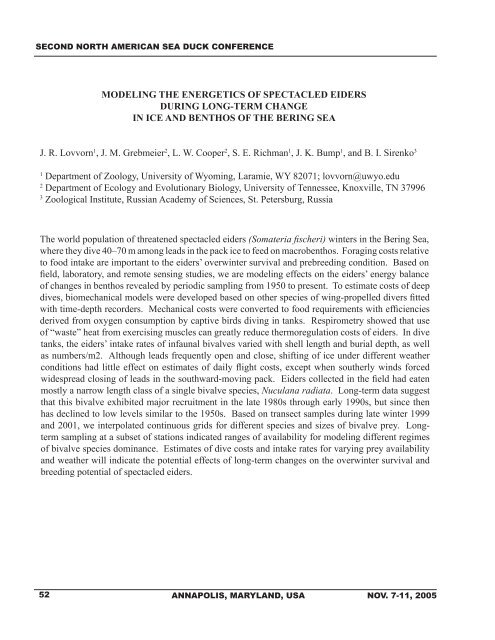Second North American Sea Duck Conference - Patuxent Wildlife ...
Second North American Sea Duck Conference - Patuxent Wildlife ...
Second North American Sea Duck Conference - Patuxent Wildlife ...
Create successful ePaper yourself
Turn your PDF publications into a flip-book with our unique Google optimized e-Paper software.
SECOND NORTH AMERICAN SEA DUCK CONFERENCE<br />
MODELING THE ENERGETICS OF SPECTACLED EIDERS<br />
DURING LONG-TERM CHANGE<br />
IN ICE AND BENTHOS OF THE BERING SEA<br />
J. R. Lovvorn 1 , J. M. Grebmeier 2 , L. W. Cooper 2 , S. E. Richman 1 , J. K. Bump 1 , and B. I. Sirenko 3<br />
1 Department of Zoology, University of Wyoming, Laramie, WY 82071; lovvorn@uwyo.edu<br />
2 Department of Ecology and Evolutionary Biology, University of Tennessee, Knoxville, TN 37996<br />
3 Zoological Institute, Russian Academy of Sciences, St. Petersburg, Russia<br />
The world population of threatened spectacled eiders (Somateria fischeri) winters in the Bering <strong>Sea</strong>,<br />
where they dive 40–70 m among leads in the pack ice to feed on macrobenthos. Foraging costs relative<br />
to food intake are important to the eiders’ overwinter survival and prebreeding condition. Based on<br />
field, laboratory, and remote sensing studies, we are modeling effects on the eiders’ energy balance<br />
of changes in benthos revealed by periodic sampling from 1950 to present. To estimate costs of deep<br />
dives, biomechanical models were developed based on other species of wing-propelled divers fitted<br />
with time-depth recorders. Mechanical costs were converted to food requirements with efficiencies<br />
derived from oxygen consumption by captive birds diving in tanks. Respirometry showed that use<br />
of “waste” heat from exercising muscles can greatly reduce thermoregulation costs of eiders. In dive<br />
tanks, the eiders’ intake rates of infaunal bivalves varied with shell length and burial depth, as well<br />
as numbers/m2. Although leads frequently open and close, shifting of ice under different weather<br />
conditions had little effect on estimates of daily flight costs, except when southerly winds forced<br />
widespread closing of leads in the southward-moving pack. Eiders collected in the field had eaten<br />
mostly a narrow length class of a single bivalve species, Nuculana radiata. Long-term data suggest<br />
that this bivalve exhibited major recruitment in the late 1980s through early 1990s, but since then<br />
has declined to low levels similar to the 1950s. Based on transect samples during late winter 1999<br />
and 2001, we interpolated continuous grids for different species and sizes of bivalve prey. Longterm<br />
sampling at a subset of stations indicated ranges of availability for modeling different regimes<br />
of bivalve species dominance. Estimates of dive costs and intake rates for varying prey availability<br />
and weather will indicate the potential effects of long-term changes on the overwinter survival and<br />
breeding potential of spectacled eiders.<br />
52 ANNAPOLIS, MARYLAND, USA NOV. 7-11, 2005












